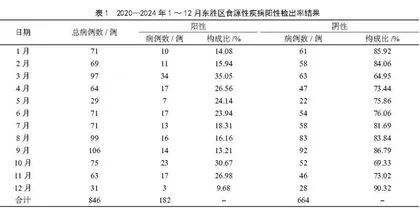2020—2024年鄂尔多斯市东胜区食源性疾病病原学分析
作者: 刘琴琴 赵龙

摘 要:目的:分析2020—2024年鄂尔多斯市东胜区食源性疾病病原学监测结果,为食源性疾病防控工作提供科学依据。方法:收集病原学监测哨点医院上报的846例病例信息,按照时间、人群、暴露场所和暴露食品分布等进行描述性流行病学分析。结果:2020—2024年东胜区食源性疾病病原学总体阳性检出率为21.51%,1~12月阳性检出率差异有统计学意义(χ2=29.303,P<0.05),阳性检出率较高的月份为3月和10月,分别为35.05%和30.67%。846例病例中,男性阳性检出率为20.65%,女性阳性检出率为22.57%,男女阳性检出率差异无统计学意义(χ2=0.461,P>0.05)。各年龄组阳性检出率差异有统计学意义(χ2=11.221,P<0.05)。182例阳性病例中,诺如病毒和大肠埃希氏菌双重阳性11例,诺如病毒占比最高,为66.48%,大肠埃希氏菌占比次之,沙门氏菌占比最低。可疑进食场所居前三位的是家庭、餐饮服务业和学校。可疑食品种类居前三位的是水果及其制品、混合食品和粮食类及其制品。结论:东胜区应关注诺如病毒和大肠埃希氏菌引起的食源性疾病防控。高危人群为25~44岁、≤4岁和5~24岁,主要发病场所为家庭,水果及其制品、混合食品和粮食类及其制品需要引起高度重视。诺如病毒是引起东胜区食源性疾病的主要
致病菌。
关键词:食源性疾病;病原学;流行特征
Etiological Analysis of Foodborne Diseases in Dongsheng District of Ordos City from 2020 to 2024
LIU Qinqin, ZHAO Long*
(Dongsheng District Centers for Disease Control and Prevention, Ordos 017000, China)
Abstract: Objective: To analyze the results of foodborne disease pathogen surveillance in Dongsheng district of Ordos city from 2020 to 2024,and to provide a scientific basis for foodborne disease prevention and control work. Method: Information of 846 cases reported from sentinel hospitals for etiological surveillance was collected, and descriptive epidemiological analysis was performed according to time, population, exposure place and distribution of exposed food. Result: The overall positive detection rate of food-borne disease etiology in Dongsheng district from 2020 to 2024 was 21.51%, and the positive detection rate from January to December had statistical significance (χ2=29.303, P<0.05). The high positive detection rates were in March and October, which were 35.05% and 30.67%, respectively. Among the 846 cases, the positive detection rate was 20.65% for males and 22.57% for females, and there was no significant difference in the positive detection rate between males and females (χ2=0.461, P>0.05). The positive detection rate of all age groups was significantly different (χ2=11.221, P<0.05). Among the 182 positive cases, 11 cases were double positive for norovirus and Escherichia coli. Norovirus accounted for the highest proportion (66.48%), Escherichia coli accounted for the second, and Salmonella accounted for the lowest. The top three suspected places to eat were homes, food services and schools. The top three suspect food types are fruits and their products, mixed foods and food and their products. Conclusion: Dongsheng district should pay attention to the prevention and control of foodborne diseases caused by norovirus and Escherichia coli. High-risk groups are 25 to 44 years old, ≤4 years old and 5 to 24 years old, the main place of disease is the family, fruit and its products, mixed foods and food and its products need to pay great attention. Norovirus is the main pathogen causing foodborne diseases in Dongsheng district.
Keywords: foodborne diseases; aetiology; epidemic characteristics
食源性疾病是指食品中的致病因素进入人体引起的感染性、中毒性疾病,包括食物中毒[1]。尽管食源性疾病在很大程度上是可以预防的,但仍是当今世界上最广泛的公共卫生问题之一,也是影响我国食品安全问题的主要因素[2]。为了了解鄂尔多斯市东胜区食源性疾病的流行特征及病原学分布情况,为今后食源性疾病的监测和防控工作提供科学依据,本文对2020—2024年东胜区食源性疾病病原学监测结果进行分析。
1 材料与方法
1.1 资料来源
东胜区食源性疾病的病原学监测资料来源于食源性疾病监测报告系统,按照发病日期统计2020年1月1日至2024年12月31日病原学监测数据。
1.2 统计学分析
利用Excel整理数据、IBM SPSS Statistics 26软件分析数据。采用描述流行病学方法分析食源性疾病的病原学监测结果,率的比较采用卡方检验,以P<0.05为差异有统计学意义。
2 结果与分析
2.1 2020—2024年1~12月东胜区食源性疾病阳性检出率按年和月分布结果
采集846例病例的粪便/肛拭子样本进行沙门氏菌、志贺氏菌、副溶血性弧菌、大肠埃希氏菌和诺如病毒等常见微生物检测,总体阳性检出率为21.51%(182/846)。其中,2020年阳性检出率为12.86%(18/140),2021年阳性检出率为23.24%(33/142),2022年阳性检出率为17.73%(25/141),2023年阳性检出率为28.16%(69/245),2024年阳性检出率为20.79%(37/178)。2023年阳性检出率最高。2020—2024年1~12月阳性检出率差异有统计学意义(χ2=29.303,P<0.05),阳性检出率较高的月份是3月和10月,分别为35.05%和30.67%(表1)。
2.2 2020—2024年1~12月东胜区病原学阳性病例按时间分布结果
由表2可知,2020—2024年检出阳性病例182例,其中诺如病毒和大肠埃希氏菌双重阳性病例占6.04%(11/182),身份为散居儿童、托幼儿童和学生,主要症状为发热(体温>38 ℃),呕吐和腹泻均≥5次/d。
2020—2024年诺如病毒分别检出11例、18例、12例、45例和35例,占比为66.48%(121/182),1~12月诺如病毒分布差异有统计学意义(χ2=70.107,P<0.05),且主要集中在3月和10月,分别占24.79%(30/121)和15.70%(19/121)。2020—2024年大肠埃希氏菌分别检出7例、16例、13例、27例和1例,占比为35.16%(64/182),其中以黏附性大肠埃希氏菌属为主,1~12月大肠埃希氏菌分布差异有统计学意义(χ2=24.000,P<0.05),且主要集中在7月、8月和9月,分别占15.63%(10/64)、17.19%(11/64)和15.63%(10/64)。2020—2024年沙门氏菌分别检出2例、2例、3例、0例和1例,占比为4.40%(8/182)。副溶血性弧菌和志贺氏菌未检出。
2.3 2020—2024年东胜区不同性别和年龄食源性疾病病原学监测结果
由表3可知,846例病例中,男性465例,女性381例,男女比例1.22∶1。男性阳性检出率为20.65%,女性阳性检出率为22.57%,男女阳性检出率差异无统计学意义(χ2=0.461,P>0.05)。各年龄组阳性检出率差异有统计学意义(χ2=11.221,P<0.05),阳性检出率较高的年龄组主要集中在25~44岁、≤4岁和5~24岁。
2.4 2020—2024年东胜区食源性疾病病例进食场所以及进食食品种类分布结果
由表4和表5可知,846例病例的进食场所分布间差异有统计学意义(χ2=2 696.317,P<0.05),进食场所居前三位的是家庭、餐饮服务业和学校。食品种类分布间差异有统计学意义(χ2=450.823,P<0.05),食品种类居前三位的是水果类及其制品、混合食品和粮食及其制品。
3 结论与讨论
为了解和掌握东胜区食源性疾病的流行和病原学分布特征,本文对2020—2024年东胜区食源性疾病病原学监测数据进行统计分析。2020—2024年累计病原学监测846例,总体阳性检出率为21.51%,2020年阳性检出率为12.86%,2021年阳性检出率为23.24%,2022年阳性检出率为17.73%,2023年阳性检出率为28.16%,2024年阳性检出率为20.79%。东胜区自2020年启动主动监测哨点医院后,随着卫生行政部门的不断重视,哨点医院监测力度的不断加大,病原学监测数量整体呈现增长趋势,而阳性检出率则呈现上下波动趋势,提示近年来东胜区食源性疾病可能并未得到有效控制。2023年阳性检出率最高,可能原因为感染者及时到医院就诊,同时哨点医院监测和检测力度加大,提高了阳性检出率。
2020—2024年1~12月总体阳性检出率差异有统计学意义(χ2=29.303,P<0.05),阳性检出率较高的月份是3月和10月,分别为35.05%和30.67%,与柳州市[3]、日照市东港区[4]和宜昌市西陵区[5]等地区报道的7~10月、6~9月和7~9月是食源性疾病高发季节不一致,提示东胜区3月和10月更应该关注食源性疾病的防控。
病原学检测结果显示,男性阳性检出率为20.65%,女性阳性检出率为22.57%,男女阳性检出率差异无统计学意义(χ2=0.461,P>0.05),提示东胜区男女人群感染食源性疾病的风险趋于一致,与北京市怀柔区[6]、徐州市[7]、深圳市龙华区[8]和内蒙古[9]等地区报道一致。